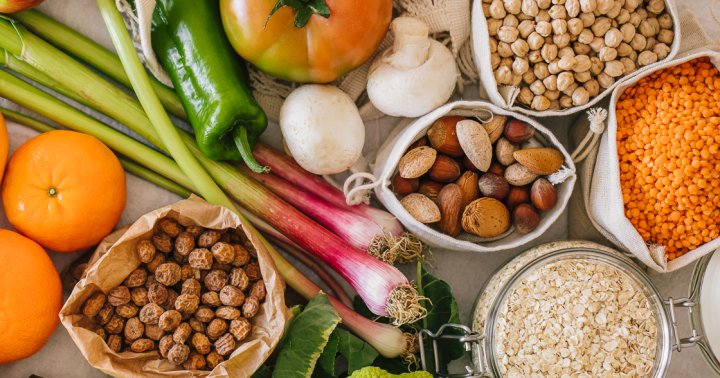This "Hormone Balancing" Practice Isn't Backed By Science: What To Do Instead
A women's health nutritionist lends her perspective.


Registered dietitian
Registered dietitian
Lauren Manaker is an award-winning registered dietitian, freelance writer, and three-time book author who has been in the field for over 20 years. She is a frequent contributor to many media outlets, a national speaker, and a content creator for @LaurenLovesNutrition, with a special focus on women's health.
Image by Gina Neonakis / iStock August 24, 2023 Our editors have independently chosen the products listed on this page. If you purchase something mentioned in this article, we may Seed cycling involves eating certain seeds during different phases of one's menstrual cycle. The practice is supposed to provide the body with compounds that support estrogen and progesterone levels, depending on the seed selection of the week. But does seed cycling really promote hormone health, or is it yet another nutrition trend that comes with more bark than bite? In this article, we'll dig into what seed cycling is and whether it actually works, based on scientific research and expert opinion.
Advertisement
This ad is displayed using third party content and we do not control its accessibility features.
What is seed cycling?
Seed cycling involves consuming specific types of seeds—namely flax, pumpkin, sesame, and sunflower—during certain phases of the menstrual cycle. The aim is to regulate estrogen and progesterone levels, potentially easing symptoms of imbalances in these hormones.
To practice seed cycling, one just needs to identify what stage of the menstrual cycle they're in.
During the follicular phase, which is the first half of the cycle, one will consume flaxseeds and pumpkin seeds due to their potential to support estrogen production. In the second half of the cycle, known as the luteal phase, sesame and sunflower seeds are suggested for their alleged benefits in boosting progesterone levels.
The concept of seed cycling doesn't appear to have a single identifiable originator. However, it has been promoted by many naturopathic doctors and wellness practitioners.
Summary
Seed cycling is the practice of eating certain seeds during different phases of the menstrual cycle: flaxseeds and pumpkin seeds during the follicular phase and sesame and sunflower seeds during the luteal phase.
Advertisement
This ad is displayed using third party content and we do not control its accessibility features.
What is it used for?
Seed cycling is touted as a solution for people who want to balance their hormones, specifically estrogen and progesterone.
“Hormonal imbalances show up in myriad ways, including irregular menstrual cycles, mood swings, fatigue, weight fluctuations, hair loss, and skin issues," Sara Gottfried, M.D., board-certified physician and Clinical Assistant Professor in Dept. of Integrative Medicine and Nutritional Sciences at Thomas Jefferson University, explains. "Additionally, issues like hot flashes, low libido, and disrupted digestion can also be caused by imbalances in your hormones.”
Those who are experiencing any of these challenges may be motivated to try seed cycling to find natural relief without medication. People who are managing Polycystic Ovary Syndrome (PCOS), are going through the perimenopausal transition, or are post-menopausal may be especially drawn to the practice.
Summary
Seed cycling is thought to help promote hormonal health and treat imbalances in estrogen and progesterone hormones. It's especially popular among those who are struggling with PCOS or menopause symptoms.
Advertisement
This ad is displayed using third party content and we do not control its accessibility features.
Why would seeds help with hormones?
Wondering what eating seeds could possibly have to do with your hormones? “Theoretically, some of the nutrients contained in the seed cycling regimen could potentially help balance hormones by supporting hormone production, metabolism, or excretion,” Melissa Groves Azzaro, RDN, LD, registered dietitian and author of A Balanced Approach to PCOS, shares.
According to Azzaro, each seed may support hormone health due to its various nutrients. For example:
Summary
The idea behind seed cycling is that flaxseeds and pumpkin seeds contain nutrients that support healthy estrogen levels. And the nutrients in sesame and sunflower seeds help keep progesterone levels where they need to be.
Advertisement
This ad is displayed using third party content and we do not control its accessibility features.
Is there any science that supports it?
Even though the theory behind seed cycling is promising, there isn’t ample science to support this practice in the medical literature.
Azzaro points out that “only recently has there been published research on the seed cycling regimen.”
In a randomized study5 published earlier this year, 20 women with PCOS followed a seed cycling regimen in addition to following a portion-controlled diet and exercising. “This study did show a small decrease (1.5-2%) in luteinizing hormone levels compared with the control group,” which is a hormone that impacts sexual health and reproduction.
However, Azzaro shares that “improvements in symptoms and menstrual regularity were not reported.”
Azzaro also highlights an older study6 (published in 1993) on 18 women that “suggested that consuming flaxseed daily throughout the entire menstrual cycle (the typical dose was 30 grams or about 1/4 cup) may help regulate menstrual cycles and lengthen the luteal phase, but the dose studied is about 4x that used in the seed cycling regimen as it's typically described.”
That's not to say that flax, pumpkin, sunflower, and sesame seeds aren't good for your overall hormone health. Including them in your diet in any form or fashion may have the following benefits:
Summary
While some seeds (particularly flax and pumpkin seeds) may support hormone health, there is very little research to show that following a strict seed cycling protocol will be any more beneficial than eating these seeds normally as part of a balanced diet.
Advertisement
This ad is displayed using third party content and we do not control its accessibility features.
My thoughts as an RD focused on women’s health
In my opinion, seed cycling has its pros and cons.
On one hand, committing to the seed cycling regimen guarantees that you will be including healthy fats, fiber, and minerals in your diet every day via the seeds you are consuming. This habit likely won’t cause any negative effects, and it may result in positive hormonal health outcomes.
On the other hand, seed cycling can be a tedious habit to maintain. Consuming servings of specific seeds every day can become tiresome.
At the end of the day, I am thrilled to support people’s desire to eat more seeds. It is less important to me to see people commit to only eating certain seeds at certain times of the month.
Ultimately, as a registered dietitian, I determine whether seed cycling is right for each individual on a case-by-case basis. While I never proactively recommend seed cycling, if a client approaches me interested in adopting this practice and has a healthy relationship with food, I will support their journey.
But if a person can become fixated on their seed intake and this habit is a source of stress, I try and find other ways for the individual to include these beneficial nutrients in their diet.
At the end of the day, I am thrilled to support people’s desire to eat more seeds. It is less important to me to see people commit to only eating certain seeds at certain times of the month.
Tips for seed cycling
If you are curious to give seed cycling a try, aren't prone to stress around food, have the time and energy to put towards the practice, and have cleared it with your healthcare provider, here are some tips to help you get started:
The first half of your cycle (follicular phase) requires flax and pumpkin seeds, rich in omega-3 and zinc. The second half (luteal phase) requires sunflower and sesame seeds, high in Omega-6 and Vitamin E. You need to figure out when you are ovulating to know which phase you are in, especially if you have irregular cycles.
Note that if you are on hormonal birth control, you may not see extreme effects when seed cycling, as your medication is influencing your cycle and hormone levels. However, there is little downside to seed cycling when on the pill, and doing so will fuel your body with healthy fats, fiber, and other nutrients that many of us need more of.
Seeds should be freshly ground to ensure optimal absorption of their nutrients.
Consistency is key in seed cycling. Try to consume one to two tablespoons of the appropriate seeds daily.
Improving hormonal health takes time, and the effects might only be noticeable after a few cycles. Don’t expect overnight results.
5.
Complement it with a balanced diet
Seed cycling should be part of a balanced, nutritious diet for best results. Cycling seeds but avoiding produce, whole grains, and other important food groups won’t make you healthier, no matter how committed you are to your seed intake.
Recipes
Adding seeds to your daily diet can provide a boost of macronutrients, phytonutrients, and fiber—regardless of whether or not you are in full-on seed cycling mode. Here are a few recipe ideas that can easily incorporate seeds:
Other ways to support hormone health using food
Seed cycling isn’t the only way that people can support their hormonal health using food.
Azzaro shares that one of her favorite ways to balance out high estrogen is to "focus on the foods necessary to help your body eliminate excess estrogen.” She adds that cruciferous vegetables (like Brussels sprouts and cauliflower), berries, and soluble fiber (like that found in oats and psyllium) may help eliminate excess estrogen9.
“For period problems like PMS and cramps, including omega-3 fatty acids in your diet regularly can help lower prostaglandins," she explains. Consuming adequate magnesium can also help relax muscles, she adds.
At the end of the day, “Eating a varied, nutrient-dense diet high in fruits and vegetables, quality animal proteins, and legumes, nuts, and seeds sets your body up to have all the raw materials it needs to make, detoxify, and eliminate hormones properly,” says Azzaro.
Seed cycling side effects
Despite its growing popularity, it's essential to note that seed cycling does have potential side effects. Some individuals may experience mild digestive discomfort when introducing new seeds into their diet. Allergies to specific seeds could also pose a risk. However, these side effects are relatively rare and individual-specific. As with any dietary change, it's best to consult with a healthcare professional before starting seed cycling.
Frequently Asked Questions
Does seed cycling work?
Anecdotally, seed cycling helps people balance certain hormones naturally. But since there is very limited data supporting its beneficial outcomes, it is challenging to say if it truly works or if people are feeling the positive outcomes simply because they are including more nutrients in their diet when they adopt this practice.
Is seed cycling backed by science?
No, seed cycling is not backed by science.
Are there any risks to seed cycling?
Seed cycling comes with very little risks. People may feel gassy or bloated when they start seed cycling because their body may not be used to consuming as much fiber as what one eats when cycling. They may also have an allergic reaction to one of the seeds, which can cause negative symptoms. Finally, while not a medical side-effect, people may feel angst when following this diet, as it is a strict regimen to stick to. If a person’s mental health is being compromised when practicing seed cycling, it isn’t worth the potential health benefits.
The takeaway
Seed cycling is a natural nutritional approach thought to support the body's hormone production and regulation, but it isn't backed by science. As a women's health nutritionist, I don't see any harm in eating more seeds, but I don't think you need to worry about doing so during specific times of the month. You needn't limit yourself to the four seeds used in a seed cycling regimen, either—hemp seeds, chia seeds, fennel seeds, etc. can also be tasty and healthy diet additions.

 Tekef
Tekef 






























.jpg&h=630&w=1200&q=100&v=f776164e2b&c=1)

